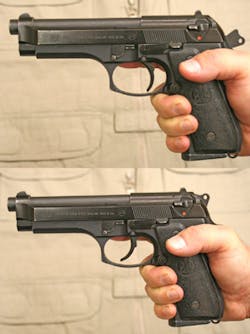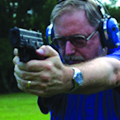As we move into Part 3 of our discussion about the usefulness of mechanical safeties on handguns, there is one additional point to keep in mind: The primary reason for having safeties on firearms in the first place is to prevent the firearm from being discharged when you don't want it to be. Although that seems obvious on the surface, there are actually two needs to consider. One is to prevent you, the intended user, from having an unintentional discharge. The other is to prevent someone else from firing the gun, whether intentional or not.
Both of these considerations carry particular importance for law enforcement officers, as there is always at least one gun present as they go about their duties... their own. It is not just essential that the firearm be safely carried and readily available for use, it must also be secure from being seized and used by others against the officer or someone else. This is the delicate balance that must be achieved through proper equipment selection and appropriate training. Indeed, the current choices in security or retention holsters are the best they have ever been. This is so because too many officers have been the victims of having their guns snatched from their holsters by determined or desperate attackers. Since this is not a discussion about holsters, I'll simply acknowledge that a good duty holster is an essential part of any officer's safety system for carrying a firearm. For now, let's concentrate on what happens when the gun leaves the holster.
Over the years, there have been many mechanical devices on handguns that have functioned as safeties in some manner. The only ones that have any usefulness on a self defense handgun are those that can be quickly activated or deactivated while the user maintains a firm shooting grip on the gun. Because of this, the typical type of safety on a service pistol today is the Thumb Safety, so named because it can be manipulated with the thumb of the shooting hand.
There are generally two categories of these, frame mounted and slide mounted. The frame mounted safety is usually simply an "on-off" switch. Typical examples of this type would be the Colt 1911 pattern pistols, the new Smith and Wesson M&P pistols (as an option), and the Ruger SR9. It either prevents the gun from firing or it doesn't. The slide mounted safeties often double as both a firing safety and as a de-cocker, which allows the safe lowering of the hammer from the cocked, single action firing position. The most common of the police service pistols with such systems are the Beretta Model 92 style guns, the Ruger P series pistols and the traditional design Smith and Wesson auto-loaders, such as the Model 5906, 4006, etc. If you have been issued a pistol with a thumb safety, it is probably because your agency is concerned about the two issues I mentioned in the first paragraph, no accidental discharges and no officers getting shot with their own guns. Does using such guns accomplish those goals? Generally, yes. Do they do so by virtue of their presence alone? Not necessarily. Let's look at the pluses and minuses.
The UP Side
One of the most important advantages of having a pistol with a mechanical safety is that it takes some knowledge on the part of the user to turn it on and get it into action. This should not be a problem for any officer, who should have sufficient training in manipulating the safety so that deploying the gun in firing condition is reflexive. As the decision to fire is made, the safety should be smoothly and quickly deactivated. Likewise, it should be smoothly and quickly reactivated when the need to fire has passed. On the other hand, any unauthorized person who gains control of the weapon may not know how to quickly begin firing the gun, giving the officer a chance to regain control of the pistol before it is used against him or her. If control is not possible, then perhaps other tactics, such as accessing a backup gun, deploying other weapons or moving to cover can be accomplished. It may take only a few seconds for the bad guy to figure it out, but officer's lives have been saved by quick reaction in those precious seconds. Operating controls that are proprietary to the gun and user are reason enough to at least consider whether your gun should have a manual safety.
Another advantage for guns that have a slide mounted safety/decocker is that they can be safely decocked from the single action firing mode without relying on two-handed, trembling, perhaps slippery fingers to lower the hammer. These guns have a built in hammer block that allows for one-handed de-cocking, either returning it to double action mode or switching it off altogether. We all know of stories of accidental discharges while someone was trying to lower the hammer on a gun with a round in the chamber. At the very least this is embarrassing. The worst cases have happened also.
Frame mounted safeties, such as on the single action semi-auto 1911 style guns, were initially considered essential because of their much lighter triggers than on the double action revolvers they usually replaced. Having one more layer of safety between you and that +/- 4 pound trigger must have seemed like a good idea to John Moses Browning. A manual safety is still a feature on the standard issue military sidearm, the Beretta M9. The lighter trigger pull of most auto-loading pistols are a key reason for having an additional manual safety, just in case a finger ends up in the trigger guard when it should not be there.
The DOWN Side
So, if thumb safeties are such a good idea, how come every gun doesn't have one? One reason is that not everyone gets the kind and amount of training that they should to insure that they do in fact operate the gun reflexively. Just as there are instances where safeties have prevented tragedies, there are incidents where officers have pulled the trigger, but their guns did not fire. Whether it was stress, poor training or some other factor, they simply did not know their gun well enough when it mattered most. They forgot to deactivate the safety. To further complicate matters, some agencies use the slide mounted safeties as de-cockers only, prescribing that the guns be carried off safe and in double action mode in their duty holsters. There is nothing wrong with this, until the safety accidentally gets pushed on without the officer being aware of it. When the pistol is deployed, it should only require a squeeze of the trigger to fire. If the officer doesn't notice that the safety is now on, the gun doesn't fire as needed. Again, the brief seconds, or even fractions of seconds, that it takes to remedy the situation can mean the difference between life and death. This is the main reason that many prefer the simplicity of a no-safety, point-gun-pull-trigger pistol. Of course, if it is that simple for the officer, it is also that simple for someone else who gets their hands on the gun.
Another issue is that many thumb safeties are now designed to be ambidextrous. This makes a lot of sense for agency guns, as they need to be used by both lefties and righties, or when an officer's primary hand is injured. But this puts one of the levers on the out-side of the gun as it is being carried. Brushing against things, as officers tend to do, can activate or deactivate such safeties, leaving the safety in the wrong position. Some people feel this is reason enough to avoid ambidextrous thumb safeties.
Which should you choose? That will depend on the philosophy of the agency, or those individual officers who make the call for themselves. How much training time will you devote to the functioning of the gun? How effective is your handgun retention training? Is there some other reason for selecting a certain pistol and the safety is either there or not, as a part of the package? Another factor that must be considered, whether we like it or not, is cost. Many agencies have moved away from the Berettas and older style Smith and Wessons in favor of less expensive and/or simpler guns, primarily the Glock pistols or the various SIG Sauer models. If that is the case, there are no manual safety options, no further discussion necessary. Many gun gurus advocate that a combat type pistol should be as simple and reliable as possible, with nothing to impede its immediate use. Sort of like, well, the revolvers they replaced. I'm good with that. Just don't pull the trigger, or let anyone else pull the trigger, and things will be fine.
Next month: The Ins and Outs of magazine safeties and grip safeties.
About the Author
Steve Denney
Steve Denney is a former municipal police sergeant, USAF Officer and chief of security/safety officer for a large retirement and healthcare community. A former SWAT officer, crime prevention officer and both military and police firearms trainer, he is currently an instructor for LFI Judicious Use of Deadly Force, LFI Stressfire, and NRA and other defensive tactics disciplines. He currently trains police, military and private citizens. He is a charter member of ILEETA and a member of IALEFI.

